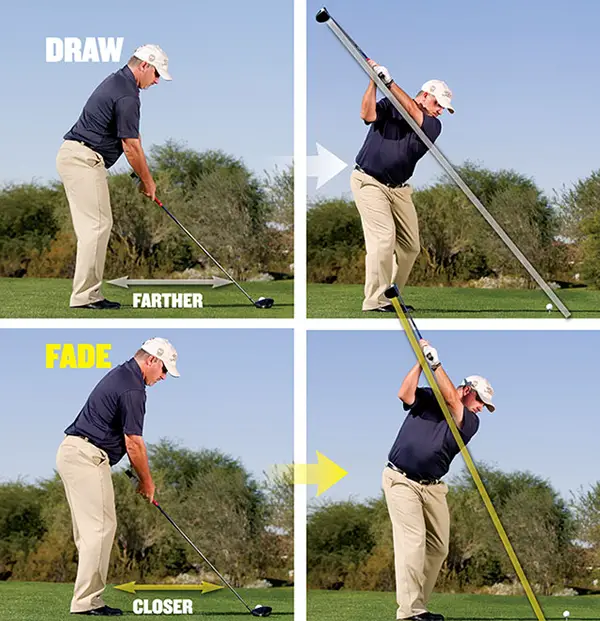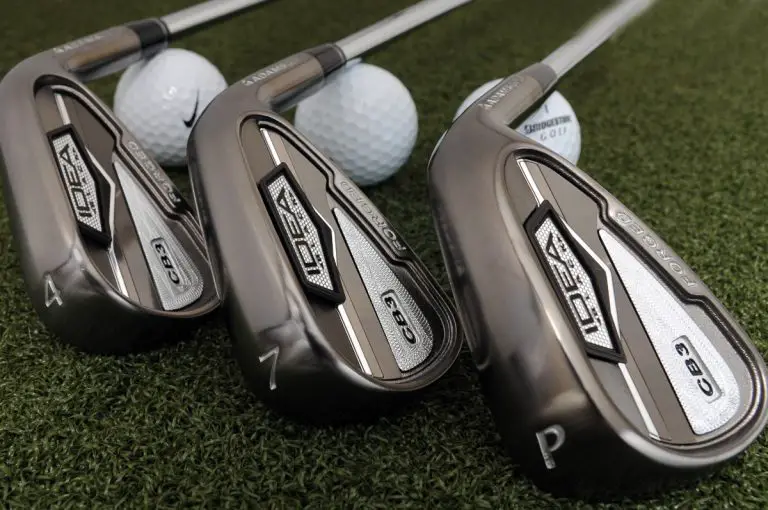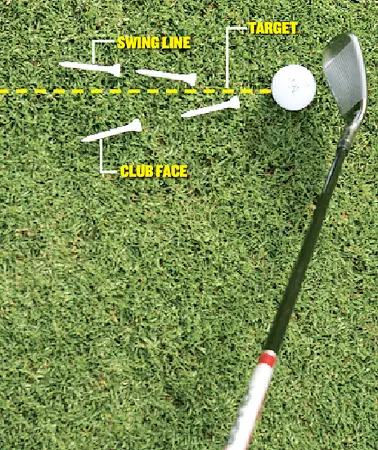How To Hit Blade Irons

Hitting blade irons with precision and finesse is a coveted skill among golfers seeking to elevate their game to new heights. As golfers strive for greater accuracy and control, mastering the art of hitting blade irons becomes a vital component of their repertoire. These sleek and elegant clubs, known for their unforgiving nature, demand a higher level of skill and technique compared to their cavity back counterparts.
In this comprehensive guide, we will delve into the intricacies of hitting blade irons and provide you with practical insights and actionable tips to improve your performance. From understanding the fundamentals of blade irons to developing a consistent swing, controlling distance and trajectory, and honing your accuracy, we will explore every facet of this essential golfing skill.
With blade irons, each shot becomes a delicate dance between power and finesse. The compact clubhead, thin top line, and minimal forgiveness require precise contact and a refined swing. However, the reward for mastering blade irons is unparalleled control over shot shaping, distance control, and the ability to navigate challenging course conditions with confidence.
Whether you are a seasoned golfer looking to refine your skills or a newcomer eager to embrace the challenges of blade irons, this guide will serve as your compass on the journey to becoming a master of precision golf shots. So, grab your clubs, lace up your shoes, and let’s dive into the world of hitting blade irons with poise and accuracy.

Understanding Blade Irons
Blade irons, also known as muscle-back irons, are clubs characterized by a compact clubhead with a thin top line and minimal forgiveness. They offer enhanced workability and allow golfers to shape shots with precision. Unlike cavity back irons, blade irons provide a more direct feedback on contact, making it crucial to strike the ball consistently in the center of the clubface.
Grip and Stance
A proper grip is essential for executing solid shots with blade irons. It is recommended to have a neutral grip, with the “V” formed by the thumb and index finger pointing towards the right shoulder for right-handed golfers (opposite for left-handed golfers). Additionally, ensure a firm yet relaxed grip, maintaining consistent pressure throughout the swing.
Your stance plays a significant role in achieving consistent ball striking. Position your feet shoulder-width apart, aligning them parallel to the target line. Distribute your weight evenly between both feet and maintain a balanced posture throughout the swing.
Ball Positioning and Alignment
The position of the golf ball relative to your stance has a direct impact on the quality of your iron shots. For most standard iron shots, position the ball slightly ahead of the center of your stance. This ensures a descending strike, allowing the clubhead to compress the ball properly.
Proper alignment is crucial for hitting accurate shots. Align the clubface directly at the target, and ensure that your body is parallel to the target line. This alignment helps establish a consistent swing path and promotes a square clubface at impact.
Developing a Consistent Swing with Blade Irons
Body Rotation and Weight Transfer
A fluid and controlled body rotation is key to a consistent swing with blade irons. Initiate the downswing by rotating your hips towards the target while maintaining a stable upper body. This transfer of weight from the back foot to the front foot generates power and promotes a crisp strike.
Maintaining balance throughout the swing is crucial. Avoid excessive lateral movement or swaying and focus on a stable base, allowing for a consistent swing plane and solid ball contact.
The Backswing
A smooth and controlled backswing sets the foundation for a well-executed iron shot. Maintain a one-piece takeaway, where your arms, shoulders, and torso move together as a unit. Avoid excessive wrist hinging or over-rotation, which can lead to inconsistency.
At the top of your backswing, ensure that the club is parallel to the ground, pointing towards the target line. This position provides optimal leverage and sets the stage for a powerful downswing.
The Downswing and Impact
The downswing is where the power and accuracy of your iron shots are realized. Initiate the downswing with a gradual transition from the top, allowing for a smooth acceleration through impact. Maintain the lag between your hands and the clubhead to maximize power and control.
Focus on striking the ball first, then taking a divot after impact. This ensures crisp contact and proper compression of the ball. Maintain a firm and controlled follow-through, allowing the club to release naturally.
Controlling Distance and Trajectory with Blade Irons
Club Selection and Loft Adjustments
Choosing the right club and managing loft is essential for controlling distance and trajectory with blade irons. Each blade iron has a specific loft angle, which affects the ball’s trajectory and distance. Understanding the loft of different clubs and making appropriate club selections will allow you to hit your desired distances more consistently.
For longer shots, such as approach shots to the green, you may choose a lower lofted blade iron, such as a 4-iron or 5-iron. These clubs will produce a lower ball flight and more roll upon landing. Conversely, for shorter shots that require more height and stopping power, you may opt for a higher lofted blade iron, such as a 9-iron or pitching wedge.
It’s important to note that the loft of the club is not the only factor influencing distance and trajectory. Your swing speed, angle of attack, and contact point on the clubface also play significant roles. Experiment with different clubs and practice shots to develop a feel for how each club performs under various conditions.
Shot Shaping Techniques
One of the advantages of blade irons is their ability to shape shots. Shot shaping refers to intentionally curving the ball in flight, either from left to right (fade) or right to left (draw). Mastering shot shaping techniques with blade irons provides you with additional options to navigate challenging course layouts and specific shot requirements.
To execute a fade, aim slightly left of the target (for right-handed golfers) and set up with an open clubface at address. During the swing, focus on swinging along your body line and allowing the clubface to remain slightly open at impact. This imparts a left-to-right spin on the ball, resulting in a controlled fade.
Conversely, to hit a draw, aim slightly right of the target (for right-handed golfers) and square the clubface at address. During the swing, focus on swinging slightly from the inside-out, with a slight closing of the clubface at impact. This imparts a right-to-left spin on the ball, producing a controlled draw.
It’s important to practice these shot shaping techniques on the driving range before attempting them on the course. With time and experience, you will develop the ability to shape shots with confidence and precision.
Managing Wind and Course Conditions
Golf is often played in varying weather conditions, including wind. Learning to adapt your blade iron shots to different wind speeds and directions is essential for maintaining accuracy and control.
When facing a headwind, it’s advisable to select a slightly higher lofted blade iron than you would under calm conditions. The additional loft helps counteract the wind’s resistance and ensures the ball maintains its intended trajectory. Similarly, when hitting into a strong tailwind, consider using a lower lofted club to keep the ball flight lower and prevent it from ballooning excessively.
Crosswinds can pose challenges when it comes to accuracy. To manage crosswinds effectively, aim slightly into the wind and allow for the wind’s effect on the ball. This adjustment compensates for the wind’s influence and helps you maintain control over the shot.
Additionally, course conditions such as uphill or downhill lies, as well as uneven terrain, can affect your blade iron shots. Adjust your setup and swing accordingly to accommodate these variations. For example, on an uphill lie, place more weight on your lead foot and swing with a steeper angle of attack to ensure clean contact with the ball.
Developing an understanding of how different course conditions impact your blade iron shots will enhance your overall game and enable you to make more informed shot selections.
Developing Consistency and Accuracy
Practice Drills for Blade Irons
Practice is crucial for developing consistency and accuracy with blade irons. Incorporating targeted drills into your practice routine can accelerate your improvement and provide tangible results on the course.
One effective drill is the target-oriented drill. Set up a specific target on the range, such as a flag or a spot, and aim to hit it consistently with your blade irons. Start with shorter irons and gradually work your way up to longer irons. This drill helps improve your focus, alignment, and shot execution.
Another valuable drill is working on distance control. Select a specific target and hit a series of shots with the same club, focusing on hitting different distances. This drill helps develop a sense of feel and allows you to gauge the distance each club carries with various swing lengths.
Incorporating situational drills into your practice routine is also beneficial. Create on-course scenarios and practice hitting specific shots, such as approach shots to tight pin positions or shots from difficult lies. This type of practice helps simulate real-game situations and prepares you for the challenges you may encounter during a round of golf.
Utilizing technology can also aid in your practice sessions. Swing analysis tools, such as launch monitors or swing analyzers, provide valuable data on your swing mechanics, clubhead speed, and ball flight. Analyzing this data can help identify areas for improvement and allow you to make targeted adjustments to your swing.
Remember, consistent and deliberate practice is key to developing proficiency with blade irons. Allocate dedicated practice time and focus on specific aspects of your game that require improvement. With patience and dedication, you will see progress and an improvement in your overall consistency and accuracy on the course.
Course Management with Blade Irons
Course management involves making strategic decisions based on the layout of the course, the specific hole, and your own abilities. Developing effective course management skills with blade irons can significantly impact your scores and overall performance.
One aspect of course management is understanding risk and reward scenarios. Evaluate the potential risks and rewards of each shot and make decisions accordingly. For example, if you’re facing a difficult approach shot over water, you may choose a more conservative club and aim for the safer part of the green rather than going for a more aggressive shot.
Strategic shot selection is also crucial. Assess the hole and determine the best angle of attack. Sometimes, playing to a specific part of the fairway or green can provide you with better opportunities for scoring. Consider your strengths and weaknesses with blade irons and choose shots that play to your strengths.
Furthermore, course conditions such as wind, firmness of the fairways, and pin positions should influence your decision-making. Adjust your club selection and shot strategy based on these factors to optimize your chances of hitting accurate shots and scoring well.
Effective course management is a skill that develops over time through experience and careful observation. Pay attention to how different shots and strategies affect your scores, and continuously refine your approach to maximize your performance with blade irons.
Common Mistakes to Avoid
Overcoming Blade Iron Challenges
Using blade irons can present challenges, especially for golfers transitioning from cavity back irons. Understanding common mistakes and knowing how to overcome them will help you make progress with your blade iron shots.
One common mistake is improper ball striking. Blade irons require precise contact in the center of the clubface. Mishits, such as hitting the ball thin or fat, can result in inconsistent distance and accuracy. To overcome this challenge, focus on maintaining a consistent swing tempo and rhythm, and practice hitting shots with a deliberate and controlled swing.
Another challenge is the temptation to swing too hard with blade irons. Unlike cavity back irons, blade irons rely more on accuracy and control rather than sheer power. It’s essential to swing within your capabilities and maintain a smooth tempo throughout the swing. This allows for better control of the clubhead and promotes cleaner ball striking.
Troubleshooting techniques can help address specific issues you may encounter with blade irons. For example, if you consistently hit shots to the right, work on correcting your alignment and ensuring that your clubface is square at impact. If you tend to hit shots to the left, focus on maintaining a relaxed grip and avoiding excessive hand rotation through impact.
Seeking professional guidance from a golf instructor is highly beneficial when working through blade iron challenges. A qualified instructor can provide personalized feedback, analyze your swing mechanics, and offer specific drills and exercises to address your unique needs. They can also help you fine-tune your technique and make necessary adjustments for improved performance.
Utilizing technology can also aid in overcoming blade iron challenges. Video analysis of your swing can provide valuable insights into areas that need improvement. Many mobile apps and devices allow you to capture your swing and review it in slow motion, helping you identify any flaws or inconsistencies.
Remember, overcoming blade iron challenges requires patience, practice, and a commitment to continuous improvement. By addressing common mistakes, seeking guidance, and leveraging technology, you can overcome these challenges and unlock the full potential of your blade iron shots.
Seeking Professional Guidance
While this guide provides a comprehensive overview of how to hit blade irons effectively, there is immense value in seeking professional guidance. A golf professional or instructor can provide personalized coaching and feedback tailored to your specific needs and skill level.
A golf professional can assess your swing mechanics, identify areas for improvement, and provide targeted instruction to enhance your blade iron shots. They have the expertise to analyze your grip, stance, alignment, and swing mechanics, and offer precise adjustments to help you achieve optimal results.
Additionally, a professional can introduce you to advanced training techniques and drills designed to improve your blade iron performance. They can guide you through progressive practice routines, track your progress, and provide ongoing support and motivation.
Technology has become an integral part of golf instruction. Many golf professionals use launch monitors, swing analysis software, and other cutting-edge tools to provide data-driven feedback and enhance the learning process. These tools offer objective measurements of clubhead speed, ball flight, spin rates, and other critical parameters, enabling a deeper understanding of your swing and aiding in targeted improvements.
By working with a golf professional, you can accelerate your progress, receive expert guidance, and develop a solid foundation for consistent and effective blade iron shots.
Conclusion:
Hitting blade irons with precision and control is a skill that can significantly elevate your golf game. By understanding the fundamentals, developing a consistent swing, controlling distance and trajectory, and focusing on accuracy, you can master the art of hitting blade irons.
Remember to focus on the grip, stance, and ball positioning to ensure a solid foundation for your shots. Develop a consistent swing with proper body rotation, weight transfer, and a smooth backswing and downswing. Experiment with club selection, loft adjustments, and shot shaping techniques to control distance and trajectory. Adapt to different course conditions and refine your course management skills to make strategic decisions.
Avoid common mistakes by troubleshooting ball striking issues and maintaining a balanced approach to power and control. Seek professional guidance from a golf instructor who can provide personalized coaching, analyze your swing, and offer tailored advice. Embrace technology as a tool for improvement and practice diligently using targeted drills and exercises.
With dedication, practice, and the guidance outlined in this article, you can become proficient in hitting blade irons and enjoy the satisfaction of executing precise and accurate golf shots. So, head to the range, put these techniques into practice, and unlock the full potential of your blade iron game.




